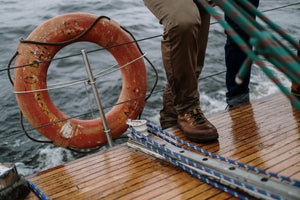
Choosing The Right Harken Winches
Winches on yachts are generally pretty durable, with a good long lifetime ahead. Eventually, however, you might want to consider changing them. Perhaps you would like self-tailing; perhaps your old winches came from a manufacturer who is no longer in business and parts supply is turning into a problem; perhaps you want to add a winch for a new function. Or maybe you just fancy something a bit shinier and more efficient.
Whatever the reason, choosing a new winch gives you a few questions to answer.
The first thing to do is to size the new winch. How this is done depends on the function it is to serve. You will find an excellent sizing guide in the Harken catalog, but let's have a look at it here.
You can probably work out how to use it straightaway, and let me assure you we use it again and again. It makes us look like a geniuses on a daily basis! However, it is worth examining one thing in more detail.
Note that the first column (genoa sheet winch - or "Primary" winch as it is often called), sizes the winch based on the 100% foretriangle area of the boat. Lots of people want to size based on their biggest genoa, but it's when the wind is blowing and we are using reduced sail that the max load is seen by the winch, and the max power is required.
Once you know what size winch you need, the next likely decision is whether it should be self-tailing or not. In this day and age for most people and most functions, self-tailing would be the first choice. In the case of Harken winches, the smallest self-tailing winch is the 15. Anything smaller than the 15, will not be self-tailing. (You can, of course, choose to use a winch that is more powerful than you need in order to get the function. You will never regret having the extra power of larger winches.)
One thing that is important in regard to self-tailers is the rope size and type. Using very hard high-tech rope will require a lot of turns and might not grip well in the jaws. Remember that the jaws want to press the rope into a triangular shape to grip it! If you use too big line in the jaws, you might damage them; this is common when people put big fat mooring lines round a winch. Look at the max line size for your chosen winch and don't exceed it. Big fat rope doesn't like going round corners anyway, so will always show more resistance than thinner rope. Not using enough wraps on the drum can also overload the jaws and cause damage.
So why would you not want self-tailing? Usually, you wouldn't want self-tailing for primary winches on a racing boat where casting off the rope into a tack is easier & faster without.
Now we know the size and the nature of the winch, we can choose the material that the drum is made of. Anodized alloy (usually grey or black) is popular as it is highly durable, light, and generally more cost effective than other finishes.
The second obvious option would be a chrome finish. This is extremely popular on cruising boats and is very attractive. The drum is commonly made from bronze which is then chromed. This results in a durable finish, but a heavier winch and a larger investment!
It's worth considering the grip on the winch drum. This will either be a surface grip (where the surface is roughened in some manner), or a form grip (where the actual shape of the drum gives the grip). The form grip is likely to be kinder to your ropes. In the case of the Harken Radial winches, the grip is shaped to drive the rope towards the bottom of the drum when easing which will help prevent overrides.
There are other finishes available, such as all-bronze or stainless steel, but these are much less common and will be considerably more expensive. If you do decide that you want all-bronze winches, be aware that you will also need to develop advanced polishing skills! That said they can look fantastic on a classic yacht.
Once you've made that selection, you are ready to choose your winch and go shopping. Make sure you have checked that the winch will fit onto the area chosen (you can get dimensions from websites and catalogs).
You might want to consider a new winch handle, please bear in mind that the power ratio of a winch (the "number" of the winch) and the winch sizing charts are determined with a 10 inch handle. If you choose an 8 inch handle, your mechanical advantage is reduced by 20%. In the case of a 40 winch, in the most powerful gear, your power is reduced from 40:1 to 32:1. But you will be able to wind faster until you run out of power!
In summary, questions you should ask are:
- What size/power?
- Self-tailing or plain top?
- What appearance/weight?
- Will it fit?
If you want or need guidance regarding Harken winches or anything else, please don't hesitate to get in touch with us.




